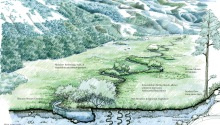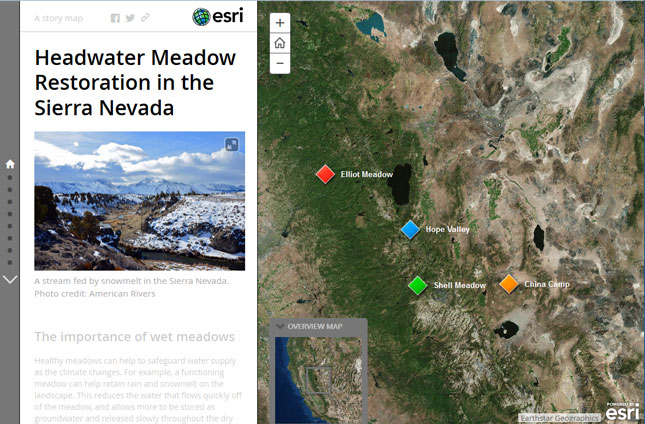
Project Summary
In California and western Nevada, the majority of fresh water comes from the Sierra Nevada, falling as winter snow that slowly melts throughout the spring and summer, delivering enormous quantities of water to the region. Climate change is expected to increase the proportion of precipitation falling as rain instead of snow, increase the incidence of rain-on-snow events, reduce overall accumulation of snow and accelerate the spring snowmelt. The overall result will be increased high flows during winter and spring and prolonged dry summer seasons.
Numerous empirical and modeling studies demonstrate that mountain meadows with intact hydrology provide a suite of benefits that address the climate change impacts predicted for the Sierra Nevada. Healthy mountain meadows can increase groundwater storage capacity, attenuate peak flows, prolong summer base flows, and reduce in-stream water temperatures. However, thousands of acres of meadows in the Sierra have been impacted by historic and ongoing land uses, which have altered their natural hydrology and impaired their ability to provide these critical benefits.
Under this project, federal, state, and NGO partners came together to restore four meadows in four watersheds in California and western Nevada. The goal is to accelerate the pace of restoration by establishing partnerships, developing expertise and demonstrating techniques to a range of stakeholders.
External Source
Related documents and resources
Project background and scope
Under the altered precipitation and hydrologic conditions predicted for the Sierra Nevada, meadows are especially important for safeguarding California’s ecosystems, wildlife, and water supplies. Studies demonstrate that meadow restoration (defined here as restoring a naturally shallow water table and meadow floodplain) is capable of helping to address the very same impacts that climate modelers predict. Specifically, the restoration of meadows results in attenuated peak flows, prolonged summer base flows, reduced in-stream water temperatures, and increased groundwater storage capacity.
Healthy, functioning meadows have shallow groundwater tables and stream banks that are low enough to allow flows to frequently flood the meadow surface. In this way, these fine-grained, sod-covered meadows act as natural reservoirs, soaking up snowmelt and rainfall runoff and then slowly releasing it over many months. As a result, less water flows downstream during peak runoff periods (winter and spring) when water is not in high demand and more is released during the summer dry season. In addition, the subsurface flows keep streams cool. Healthy meadows also support native plant communities with long, dense root structures and woody riparian vegetation that help reduce erosion and filter sediment. Meadows also provide key habitat for many animal species because they provide water and shade during the three- to six-month dry season, and promote lower summer stream temperatures, higher plant productivity, increased insect prey availability, and special habitats such as willow thickets. Mountain meadows are singled out as the single most important habitat type for migratory songbirds (Graber 1996).
However, an estimated 130,000 to 200,000 acres (40 to 60%) of Sierra meadows have been degraded as a result of historic land uses and are in need of restoration. In degraded meadows, low, frequently flooding streams are replaced by deeply eroded stream channels that quickly drain water away from the meadow, drawing down the natural water table. This in turn encourages non-meadow species to take over and reduces species diversity and productivity. Incised stream channels also lead to increased erosion and siltation downstream.
This project involved advancing restoration of four mid-elevation meadows in California and Nevada. This restoration effort focused on mid-elevation meadows because they are predicted to experience the most intense changes in hydrology (most significant changes in the proportion of precipitation falling as rain instead of snow) and because they are keystone habitats that will play a critical role in the water cycle shifts predicted under climate change. In addition, each of these four sites was identified as priority sites for restoration by the US Forest Service for their ecological value.
The four sites being restored as part of this project are: 1) Hope Valley Meadow, a ~1,600 acre meadow complex located along the West Fork of the Carson River near Carson Pass within the Humboldt-Toiyabe National Forest. 2) Shell Meadow, a 3-acre site located near Sonora Pass along a tributary to the Middle Fork Stanislaus River within the Stanislaus National Forest 3) Elliot Meadow, a 20-acre site on Shirttail Creek, a tributary to the North Fork American River, in the American River District of the Tahoe National Forest. 4) China Camp Meadow, a 30-acre meadow also located on the Humboldt-Toiyabe National Forest, in Nevada across the state line from Bridgeport, CA, on a tributary to the Walker River.
For each meadow, American Rivers and partners have worked to develop project designs that employ a process-based approach aimed at the root of the problem: an altered hydrology that will be further stressed by climate change. The project team developed restoration plans for each project site that address the primary cause of meadow degradation. More specifically: 1) In Hope Valley we will employ vegetation and bank stabilization techniques to reduce erosion, encourage aggradation, and improve fish and wildlife habitat and conditions for beavers. This will in turn accelerate the rate at which beavers repair this large meadow. 2) In China Camp Meadow we will use grade controls to repair an eroding channel and reconnect the channel and floodplain, which will also improve key rearing and lekking habitat for sage grouse in a wetland island that is surrounded by high desert. 3) In Shell Meadow in the Stanislaus River watershed, where a large headcut threatens to erode the entire meadow, we will repair the headcut and work with the USFS and the grazing permittee to develop a grazing plan that is compatible with meadow restoration. 4) In Elliott Meadow in the American River watershed, we will fill ditches and restore natural groundwater levels to keep invading non-meadow species at bay, restore natural surface flow and increase baseflows.
Project Process and Implementation
As noted above, the four sites included in this project were chosen for their mid-elevation location and because they had been identified as priority sites for restoration for their ecological value. In general, American Rivers takes a five step approach to meadow restoration projects: 1) Assessment and Design, 2) Environmental Compliance and Permitting, 3) Implementation, and 4) Adaptive Management and Monitoring. Specific details of the process and implementation of each site are included below.
In Hope Valley, a 2007 watershed assessment by MACTec Consulting identified the upper reach of the meadow as incised and unstable. In 2011, project partners hired design consultants to evaluate restoration options and develop concepts. These concepts were reviewed by a technical advisory committee of stakeholders, with the Forest Service as the ultimate decision maker. Restoration designs were completed in 2014 and the partners pursued funding for restoration. During the fundraising effort, the Department of Fish and Wildlife (CDFW) requested that the project team extend the restoration boundaries downstream onto CDFW-owned land. Designs were completed for this extended reach, and the project became a multi-agency partnership, with the National Fish and Wildlife Foundation (NFWF), CA Wildlife Conservation Board and Wildlife Conservation Society as primary implementation funders. NFWF and the Sierra Nevada Conservancy funded the design and permitting phases.
China Camp Meadow is important sage-grouse habitat, and meadow restoration efforts were aimed at improving this habitat. The project used rock grade controls to improve stream channel slope and elevation, and controlled burning to encourage native vegetation growth. The project was completed in 2015.
In 2005, grazing permittees identified a moderate headcut at the lower end of Shell Meadow that was threatening to erode through the meadow. Since that time, the headcut has grown many times in size and has begun to move upstream. The site is breeding habitat for Yosemite toad. Headcut stabilization was scheduled for 2013, but the Rim Fire and subsequent Endangered Species Act listing of the Yosemite toad caused delays. The project will be completed in 2015.
The Forest Service identified a constructed ditch that concentrates flow and drains groundwater from Elliot Meadow for restoration in 2007. Trees have grown up adjacent to the ditch, some 24 inches in diameter and more. In 2015, project partners will restore the site by removing the trees, filling the ditch with material from offsite, and grading the berms flat to restore natural surface flow. Invasive Klamath weed will be treated with releases of Klamath weed beetle.
The roles of project partners are as follows:
- American Rivers: Write and manage grants and subcontracts, convene stakeholders, apply for permits for Hope Valley, manage Hope Valley, project specific monitoring.
- Humboldt-Toiyabe National Forest: Review and approve designs, complete NEPA, oversee construction in the field for Hope Valley. Design and construction in China Camp.
- Stanislaus National Forest: Design, NEPA permits, construction and monitoring
- Tahoe National Forest : Design, NEPA and construction oversight in Elliot meadow.
Additional partners for Hope Valley include:
- California Department of Fish and Wildlife: Approved funding through Wildlife Conservation Board. Approved designs for CDFW-owned lands. Consulted on designs for restoration.
- Alpine Watershed Group and Friends of Hope Valley: Outreach to stakeholders, flow monitoring, coordinate volunteer plantings.
- Institute for Bird Populations Avian monitoring, consult on designs from a migratory bird perspective
- Trout Unlimited: Aquatic monitoring, consult on designs from a fish perspective
- Waterways Consulting: Site assessment, project designs, oversee construction in Hope Valley
American Rivers, The Humboldt-Toiyabe National Forest and Waterways Consulting worked closely throughout the design review and permitting process.
Project Outcomes
The overall goal of this project is to increase resiliency of headwaters regions through the protection and restoration of mountain meadows.
Anticipated outcomes include:
- Implementation of four on-the-ground restoration meadow restoration projects in headwater regions in the Sierra Nevada. This will result in improved hydrologic processes on 400 acres in four meadows across four watersheds, and will help to lessen the effects of reduced snowpack due to climate change.
- 4,500 feet of stream habitat enhanced for fish and wildlife, enhancing climate adaptability for a range of species including the following sensitive species: willow flycatcher (Endangered), Sierra Nevada yellow-legged frog (Candidate sp.), Yosemite toad (Candidate sp.) and sage grouse (ESA candidate species)
- Enhancement of the benefits healthy meadows provide including: increased groundwater storage capacity, reduced peak flows, prolonged summer base flows, reduced in-stream water temperatures, and reduced sedimentation downstream.
- Outreach to key stakeholders regarding meadow restoration tools, processes and incorporating climate change science in meadow restoration.
Project challenges and lessons learned
Several lessons arose from this project, including:
- Information transfer between forests and regions is exceptionally valuable and can be facilitated by a non-federal partner.
- The flexibility of a non-federal partner (in this case, American Rivers) enabled efficient contracting and the ability to select the contractor based upon qualifications.
- Environmental compliance and permitting can be a significant obstacle for the USFS, due to limited resources and lack of expertise. For example, the Humboldt-Toiyabe is seldom required to complete CEQA or other California specific permitting because the Forest is primarily located outside of California, and except for projects completed with California state funding, CEQA is not required. This presented a knowledge/experience gap that had to be addressed. However, our experience has indicated that once Forest Service gain experience on one project they are far better equipped to pursue additional projects with greater independence.
Learning Objectives
Partnerships can greatly accelerate the pace of restoration, especially in landscapes with active stakeholders. This is an example of a federal/state partnership that is working; however, a critical element is a non-government partner intent on involving stakeholders and able to efficiently contract for consulting and construction assistance.


